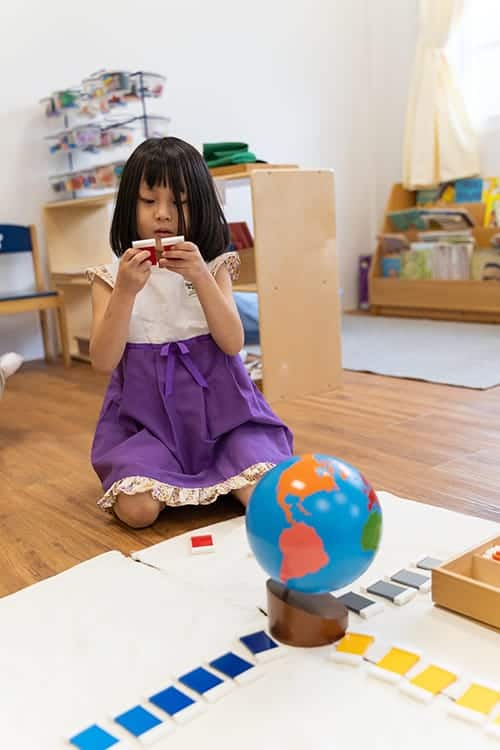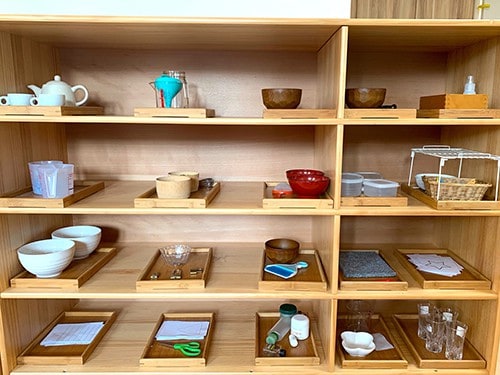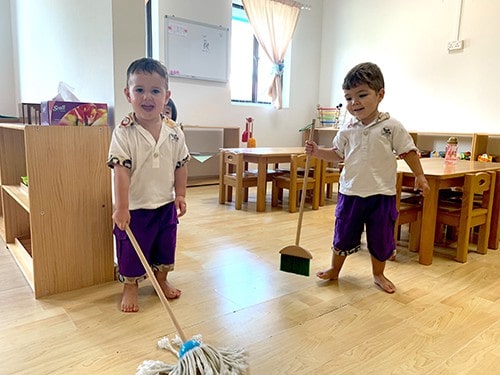“The child has a different relation to his environment from ours… the child absorbs it. The things he sees are not just remembered; they form part of his soul. He incarnates in himself all in the world about him that his eyes see and his ears hear.” ~Maria Montessori, The Absorbent Mind.
Maria Montessori believed that the greatest factor in a child’s education was the environment — they absorb their surroundings and take their lessons from their experiences. The environment is everywhere, all the time, meaning that a child’s education is not limited to the classroom. Thankfully, Maria Montessori gave us a framework that guides teachers and parents, giving us all the tools we need to be active guides in our children’s development. At House on the Hill we are just as passionate about teaching parents about the Montessori Method as we are about teaching children with the Montessori Method. Our efforts in the classroom would be fruitless unless parents, whose impact on the child is the greatest, truly understand and approve of our purpose.

Maria Montessori was a woman ahead of her time, and her ideas about children’s development and early childhood education–such as sensitive periods for language acquisition or development of gross and fine motor movement–have since become part of many theories of education and confirmed through academic studies. One of the most important lessons she taught was to not underestimate our children and the work they do. It is not common to think of children’s activities as “work” but through Montessori we understand that all children are internally driven to seek out experiences that help them meet their developmental needs and make sense of the world around them. Our job as parents and educators is to value and understand this work; to create the right environment that allows the child to explore, learn, and develop; and to guide the child in the environment and minimally interfere.
What are some of the traits of a Montessori environment that you can bring into your home?
1.A child must have freedom of movement, freedom of exploration, freedom to interact socially, freedom from interference from others, and freedom of choice– all in order to follow their natural developmental patterns and to develop independence and confidence in their choices and skills. Part of freedom is also an understanding of freedom’s limits; we have three ground rules that guide the children and maintain order: respect for oneself, respect for others, and respect for the environment.
2. We must provide an environment that is structured and ordered. From very early on children are sensitive to order and disorder, always preferring the former. For the child, the environment of the classroom or the home acts as a model for the universe, and we owe it to them to create an environment that reflects order and is structured in a way that lets them work according to their age and ability.
3. A beautiful atmosphere, in which the space is uncluttered and the materials are simple and well-maintained, will invite the child to come in and work, learn and play.
4. Natural and real materials are always preferred. We can’t always bring children into nature, but we can do our best to use natural materials such as wood, cotton, metal and glass. Cups, plates, gardening tools, and other daily materials should be child-sized, but should also be made realistically of glass, porcelain and metal. We should teach children to use these materials safely and gently, rather than replacing them with plastic. Avoiding plastic also serves as an early lesson on sustainability.

To apply these ideas in your home and routine you’ll first have to reimagine your home as a learning tool for your child–what sorts of experiences and lessons will they be taking from this environment? What sorts of experiences do you want them to be having in this environment? There are countless ways to add Montessori into your home, and there are many blogs and online resources available.
Here are some of our tips on where to begin:
1.A key feature of a Montessori classroom that is easy to incorporate into the home is the shelf. The shelf helps demarcate your child’s materials — be it books, toys, or their own cutlery in the kitchen — and keeps them accessible to the child. To follow the principle of order and structure you can curate the materials on the shelf: keep just a few items that are appropriate to your child’s interests and abilities, and in a few weeks or months time you can rotate or change it.
2. Begin to replace the plastic cups, forks and plates you may have with glass, metal and ceramic ones. Your child will be excited to eat with the same tableware as adults! Use the sensorial difference of this tableware as a way to talk with your child about the responsibility of using these items, “do you notice how this is heavier than your plastic cup? You’ll have to hold it with two hands. If it drops it may break.” But of course accidents happen, so be understanding when something does break and help your child to clean it up.
3. Ask yourself if your child has freedom of movement, exploration and choice in your home. Sometimes our home can be unwittingly inaccessible, or we may think that by preventing a child from using certain parts of the home we are preventing disaster. But in actuality by helping them to safely and independently use sinks, light switches, or the kitchen cupboard we are freeing up a lot of our time spent washing their hands or fetching things for them while also encouraging their independence. You can use step stools in areas where your child cannot reach the sink, install light switch extenders, and provide pitchers of drinking water at their height.
4. Finally, if we wish to offer children freedom we must also offer them ways to follow the limitations and be respectful. By providing child-sized brooms, rags, and mops we allow and encourage children to clean up after themselves and respect the environment. By teaching children which materials go on which shelves (and being consistent ourselves in putting things away) we teach them to respect the materials and their friends and family who may use the materials after them.

The Montessori Method encompasses many facets of early childhood development and teaching, however it all begins in the environment. By preparing the environment to nurture our children we allow them to follow their intrinsic pattern for development, to follow their curiosities and learn from their experiences, and to develop their sense of independence and confidence.








